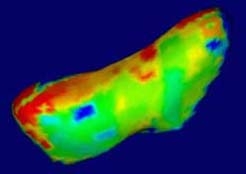
This picture of Eros, the first of an asteroid taken from an orbiting spacecraft, is a mosaic of four images obtained by NEAR (Near Earth Asteroid Rendezvous) on February 14, 2000, immediately after the spacecraft's insertion into orbit. We are looking down over the north pole of Eros at one of the largest craters on the surface, which measures 4 miles (6 kilometers) across. Inside the crater walls are subtle variations in brightness that hint at some layering of the rock in which the crater formed. Narrow grooves that run parallel to the long axis of Eros cut through the southeastern part of the crater rim. A house-sized boulder is present near the floor of the crater; it appears to have rolled down the bowl-shaped crater wall. A large number of boulders is also present on other parts of the asteroid's surface. The surface of the asteroid is heavily cratered, indicating that Eros is relatively old.
Since the NEAR spacecraft met up with and began its historic orbit of Eros on Feb. 14, NEAR team members at the Johns Hopkins University Applied Physics Laboratory in Laurel, MD, which manages the mission for NASA, have pored over images and other early scientific returns.
It will take months to unravel the deeper mysteries of Eros, but data from NEAR's final approach and first days of orbit offer tantalizing glimpses of an ancient surface covered with craters, grooves, layers, house-sized boulders and other complex features.
"Work is just starting, but it's already clear that Eros is much more exciting and geologically diverse than we had expected," says Dr. Andrew Cheng, of the Applied Physics Laboratory, who serves as the NEAR mission's lead scientist.
Scientists now know that Eros' mass is 2.4 grams per cubic centimeter -- about the bulk density of Earth's crust and a near match of the estimates derived from NEAR's flyby of Eros in December 1998.
"With this new data, it now looks like we have a fairly solid object," says radio science team leader Dr. Donald Yeomans of NASA's Jet Propulsion Laboratory in Pasadena, CA. "There is no strong evidence that it's a rubble pile like Mathilde," the large asteroid NEAR passed and photographed in 1997.
Even without in-depth analysis, pictures snapped with NEAR's Multispectral Imager offer several clues about Eros' age and geography. The large number and concentration of craters points to an older asteroid, uniform grooves across its craters and ridges hint at a global fabric and, perhaps, underground layers. In addition to numerous boulders, the digital camera has also captured brighter spots on the surface that NEAR scientists are anxious to study.
NEAR's Near-Infrared Spectrometer has picked up variations in the asteroid's mineral composition, possibly the proportions of pyroxene and olivine, iron-bearing minerals commonly found in meteorites.

A low-phase flyby during last weekend's final approach put NEAR directly between the sun and Eros, allowing the instrument to gather unique data on the asteroid's mineral makeup under optimal lighting. Combined with multispectral images, this information will help form the first mineral map ever made of an asteroid.
"We want to correlate the changes in color with the geologic features," says Dr. Scott Murchie, a science team member from the Applied Physics Laboratory. "If we see a crater, for example, is it different on the outside than on the inside? Is the face of a cliff different than the ridge? This data will eventually tell us about the asteroid's history."
For the next year, NEAR's instruments will continue to examine the potato-shaped asteroid's chemistry, geology, and evolutionary history. The mission also includes a radio science experiment to more precisely calculate Eros' density and mass distribution -- clues critical to determining the asteroid's gravity and refining NEAR's orbit.
NEAR's scientific capabilities expand soon, when its X- ray/Gamma-Ray Spectrometer and Laser Rangefinder are turned on within the next two weeks. The spectrometer will measure important chemical elements such as silicon, magnesium, iron, uranium, thorium and potassium; the laser scans will determine Eros' precise shape.
NEAR NEWS Goddard Will Search For Magnetic History Of Eros Greenbelt - February 14, 2000 - As the Near Earth Asteroid Rendezvous (NEAR) spacecraft settles into orbit around asteroid 433 Eros on Feb. 14, scientists at NASA's Goddard Space Flight Center are preparing to take full advantage of its suite of instruments to participate in the first detailed study of an asteroid.
back to main text